Fig. 9.1
Beveled wound edges inhibit proper wound edge approximation
Solution
Ensure that incision with a scalpel occurs at a 90° angle to the skin so that the wound edges may be approximated easily with the first attempt at tying a knot. If needed, de-bevel wound edges with a #15 blade or scissors (Fig. 9.2).
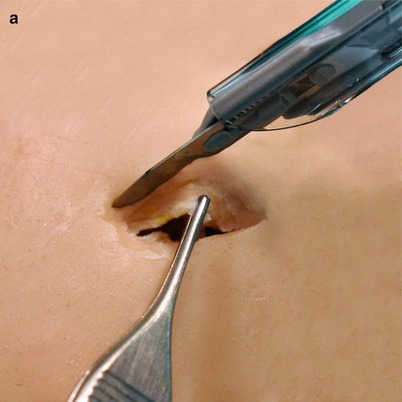
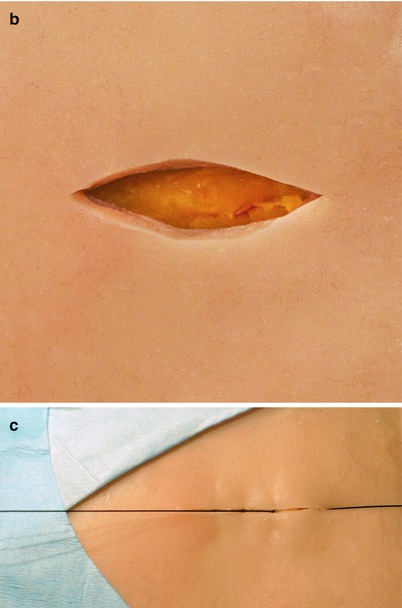
Fig. 9.2
Wound edges without bevel allow for proper wound approximation. (a) Wound bevel lifted with forceps and incised at 90° angle with scalpel. (b) Wound ‘de-beveled’. (c) Proper wound approximation after de-beveling
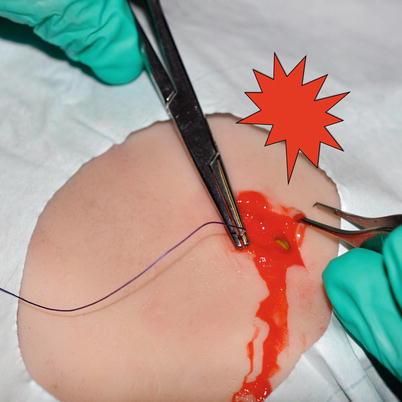
Fig. 9.3
Suturing in a bloody field forces the surgeon to operate blindly, increasing the likelihood of a splash or needle stick
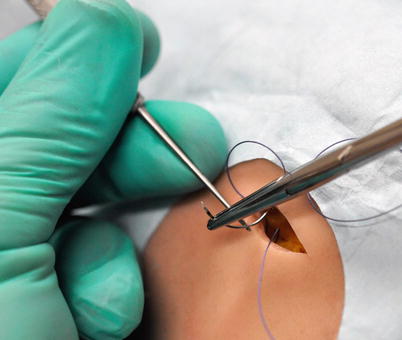
Fig. 9.4
Suturing in a bloodless field allows for visualization of sharps and reduces the likelihood of splash or needle stick
Accidents Happen When
Suturing on delicate tissue with large instruments. Using inappropriate equipment can result in poor outcomes that may need future revision.
Solution
When suturing around the eye or on other fragile tissue, the spring-loaded Castroviejo needle driver may allow for enhanced precision and a more delicate feel.
Accidents Happen When
A small caliber suture is used on a wound under high tension. The suture breaks due to tension mismatch, resulting in unanticipated recoil of the arms during cinching of the knot. This can result in a needle stick. After the suture ruptures, another attempt must be made, thus increasing the possibility of a needle stick.
Solution
The type and size of suture(s) selected should be determined by the anatomic location, the size of the defect, and the amount of anticipated tension on the wound. The smallest caliber deep suture that will relieve the most tension should be used (i.e., 3-0 caliber on torso, 5-0 caliber on face).
Accidents Happen When
A simple cuticular suture is used to repair a full-thickness defect under tension.
Solution
As a rule of thumb for full-thickness defects, tension should be relieved by deep, buried vertical mattress sutures.
Accidents Happen When
A monofilament cuticular suture is used on thin, atrophic sun-damaged skin. If the closure is under tension, the suture may tear through the skin.
Solution 1
Relieve tension with appropriate dermal sutures.
Solution 2
Use braided sutures to close the epidermal portion of the defect.
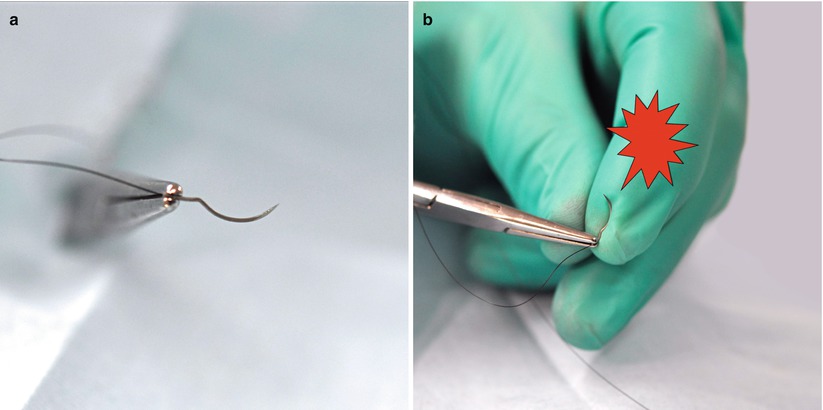
Fig. 9.5
Reshaping a bent needle. (a) Bent suture needle. (b) Needle stick occurs with reshaping the needle to its natural curvature
Solution
Discard the damaged needle and get a new one.
Accidents Happen When
A small needle driver (e.g., Webster or Halsey) (Fig. 9.6) is used with a large caliber suture needle (e.g., 3-0). The jaws of the delicate needle driver will deform over time and not be able to grip smaller suture needles (Fig. 9.7). This can result in the needle’s twisting within the needle driver. Repositioning of the now obliquely placed needle increases the risk of injury.
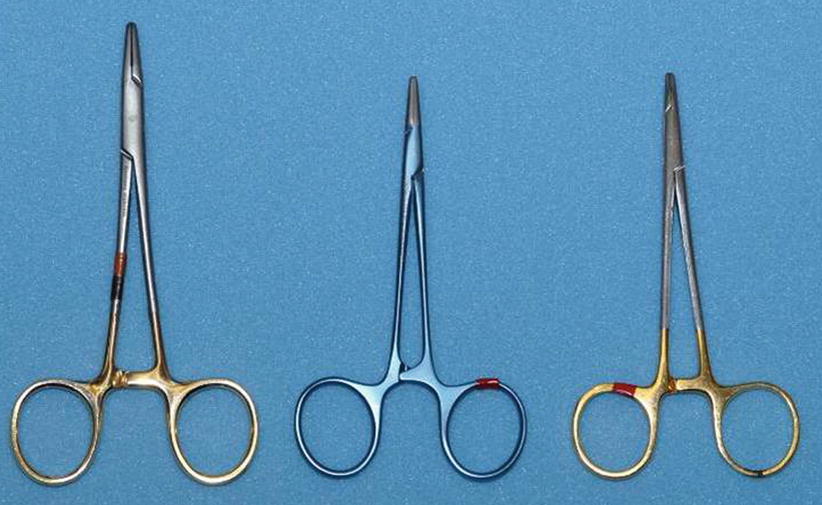
Fig. 9.6
Commonly used needle drivers in office based surgery. From left to right: Baumgartner (for larger suture needles), titanium Webster, and Halsey (latter two for smaller, delicate suture needles)
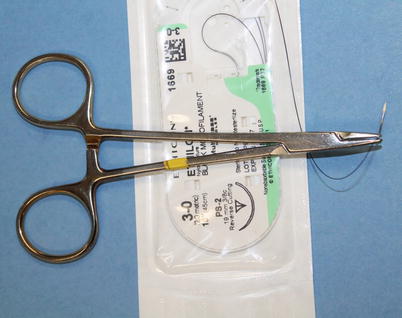
Fig. 9.7
Improperly matched suture needle (3-0) and needle driver (Webster)
Solution
Critically think about the instruments before placing them on the surgical tray. In general, sturdy instruments/materials are necessary for skin of the torso and proximal extremities while fine instruments/materials are necessary for delicate areas such as the face. Large excisions on the back call for a Baumgartner needle driver with a large caliber suture (e.g., 3-0) to minimize twisting of the needle in the instrument. Likewise, wounds on the face call for a Webster needle driver and a smaller caliber suture (e.g., 5-0 or 6-0).
Accidents Happen When
The needle is pulled out of the suture packet by grabbing the swage or suture material (Fig. 9.8). This forces unnecessary needle handling.
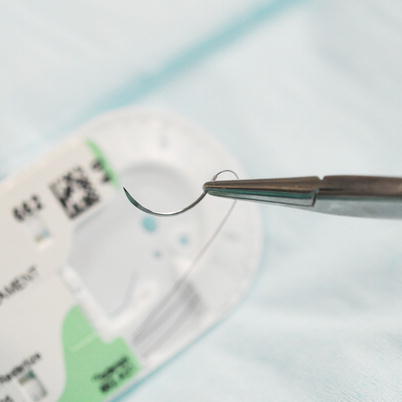
Fig. 9.8
Needle gripped too far from its point
Solution
The needle driver should grasp the needle out of the packet one-half to three-quarters proximal from the point. The manufacturer packaging facilitates this optimal gripping.
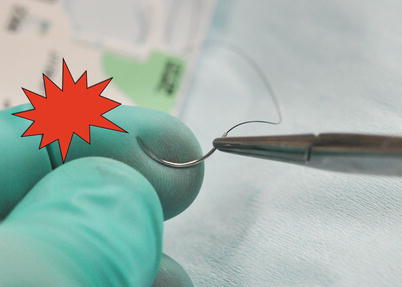
Fig. 9.9
Improper repositioning of needle with fingers near the point
Solution
The needle driver should intervene between the point and the fingers holding the swage (Fig. 9.10).
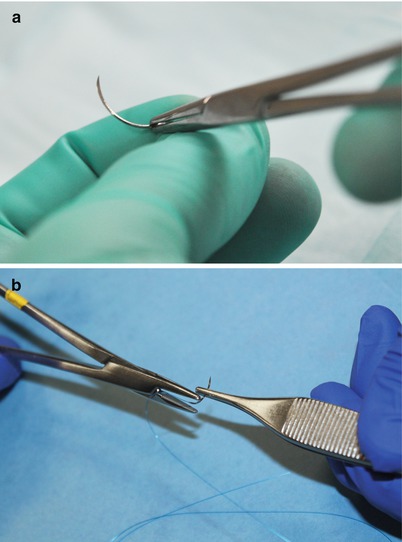
Fig. 9.10
Safe ways of needle readjustment. (a) Fingers grip the proximal end of the needle, and the needle driver acts as a barricade to the point. (b) Use forceps with smaller needles
Accidents Happen When
A finger or thumb is placed in the path of the needle in an attempt to stabilize the skin being sutured (Fig. 9.11).
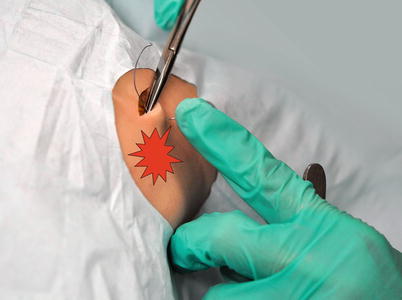
Fig. 9.11
Needle stick occurs when a finger is used to stabilize the tissue while suturing
Solution
Gently use an instrument (forceps or skin hook) to handle and evert tissue in order to create an adequate target for the suture needle (Fig. 9.12).
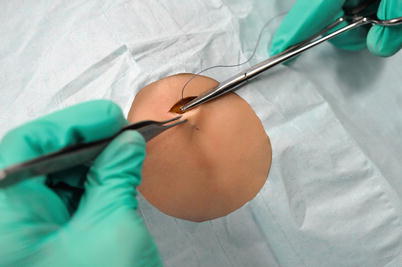
Fig. 9.12
Forceps stabilize the tissue while suturing
Accidents Happen When
Skin hooks are used unsafely during suturing. While skin hooks decrease crush injury to the epidermis and facilitate eversion of wound edges, they are an additional sharp on the surgical tray and they force the surgeon to grasp the needle with the fingers in order to reload.
Solution 1
Be mindful of the hook’s presence while operating.









